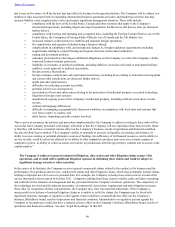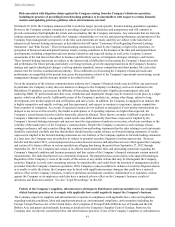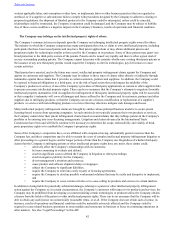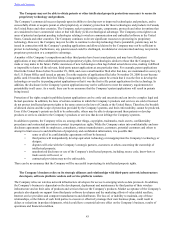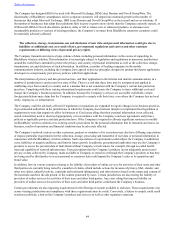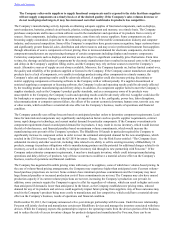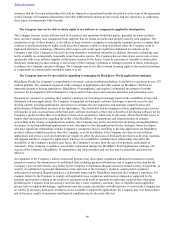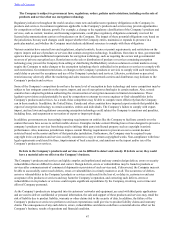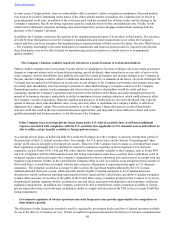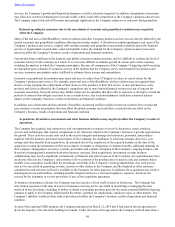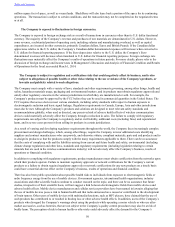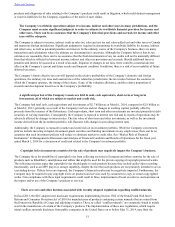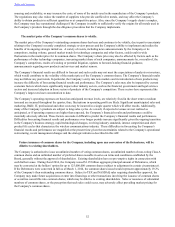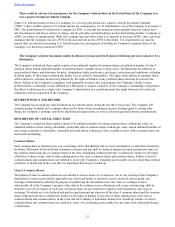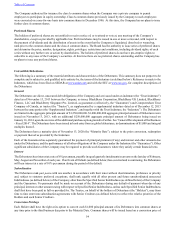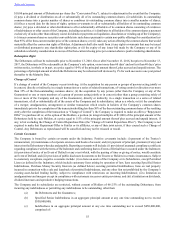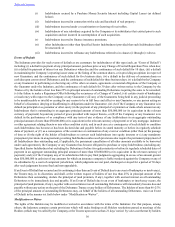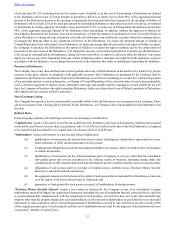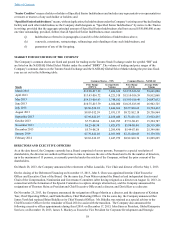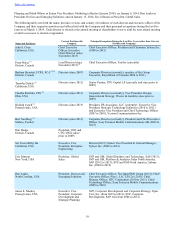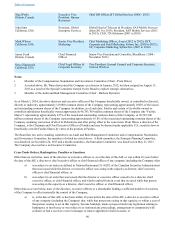Blackberry 2014 Annual Report Download - page 58
Download and view the complete annual report
Please find page 58 of the 2014 Blackberry annual report below. You can navigate through the pages in the report by either clicking on the pages listed below, or by using the keyword search tool below to find specific information within the annual report.
50
million square feet of space, as well as vacant lands. BlackBerry will also lease back a portion of the space for its continuing
operations. The transaction is subject to certain conditions, and the transaction may not be completed on the negotiated terms
or at all.
The Company is exposed to fluctuations in foreign currencies.
The Company is exposed to foreign exchange risk as a result of transactions in currencies other than its U.S. dollar functional
currency. The majority of the Company’s revenue and purchases of raw materials are denominated in U.S. dollars. However,
some revenue, a substantial portion of operating costs, including salaries and manufacturing overhead, as well as capital
expenditures, are incurred in other currencies, primarily Canadian dollars, Euros and British Pounds. If the Canadian dollar
appreciates relative to the U.S. dollar, the Company’s Canadian dollar denominated expenses will increase when converted to
U.S. dollars for financial reporting purposes. If the Euro depreciates relative to the U.S. dollar, the Company’s Euro
denominated revenues will decrease when translated to U.S. dollars for financial reporting purposes. Foreign exchange rate
fluctuations may materially affect the Company’s results of operations in future periods. For more details, please refer to the
discussion of foreign exchange and income taxes in Management’s Discussion and Analysis of Financial Condition and Results
of Operations for the fiscal year ended March 1, 2014.
The Company is subject to regulation and certification risks that could negatively affect its business, and is also
subject to allegations of possible health or other risks relating to the use or misuse of the Company’s products, or
lawsuits and publicity related to such allegations.
The Company must comply with a variety of laws, standards and other requirements governing, among other things, health and
safety, hazardous materials usage, packaging and environmental matters, and its products must obtain regulatory approvals and
satisfy other regulatory concerns in the various jurisdictions in which they are manufactured or sold. For example, the
Company’s products must be approved by the FCC before they can be used in commercial quantities in the United States. The
FCC requires that access devices meet various standards, including safety standards with respect to human exposure to
electromagnetic radiation and basic signal leakage. Regulatory requirements in Canada, Europe, Asia and other jurisdictions
must also be met. Although the Company’s products and solutions are designed to meet relevant safety standards and
recommendations globally, when used as directed, any perceived risk of adverse health effects of wireless communication
devices could materially adversely affect the Company through a reduction in sales. The failure to comply with regulatory
requirements can subject the Company to regulatory and/or civil liability, additional costs (including fines) and reputational
harm, and in severe cases prevent it from selling its products in certain jurisdictions.
As a result of varying and developing regulatory requirements throughout the world, the Company faces increasingly complex
procurement and design challenges, which, among other things, require the Company to incur additional costs identifying
suppliers and contract manufacturers who can provide, and otherwise obtain, compliant materials, parts and end products and to
re-design its products so that the products comply with the many requirements applicable to them. There can be no assurance
that the costs of complying with and the liabilities arising from current and future health and safety, environmental (including
climate change regulation) and other laws, standards and regulatory requirements (including legislation relating to certain
minerals that are used in the wireless communications industry) will not adversely affect the Company’s business, results of
operations or financial condition.
In addition to complying with regulatory requirements, product manufacturers must obtain certification from the networks upon
which their products operate. Failure to maintain regulatory approvals or network certifications for the Company’s current
products or a failure to obtain required regulatory approvals or network certifications for any new products on a timely basis
could have a material adverse effect on the Company’s business, results of operations and financial condition.
There has also been public speculation about possible health risks to individuals from exposure to electromagnetic fields or
radio frequency energy from the use of mobile devices. Government agencies, international health organizations, industry
associations and other scientific bodies continue to conduct research on the topic, and there can be no assurance that future
studies, irrespective of their scientific basis, will not suggest a link between electromagnetic fields from mobile devices and
adverse health effects. Mobile device manufacturers and cellular services providers have been named in lawsuits alleging that
the use of mobile devices poses a risk to human health and that radio emissions have caused or contributed to the development
of brain tumors. Other users of mobile devices with multimedia functions, such as MP3 players, have claimed that the use of
such products has contributed to or resulted in hearing loss or other adverse health effects. In addition, users of the Company’s
products who disregard the Company’s warnings about using the products while operating a motor vehicle or who use after-
market accessories, such as batteries, that are not subject to the Company’s quality control procedures may also be at risk of
bodily harm. The perception of risk to human health or other risks could adversely affect the demand for the Company’s
Table of Contents


